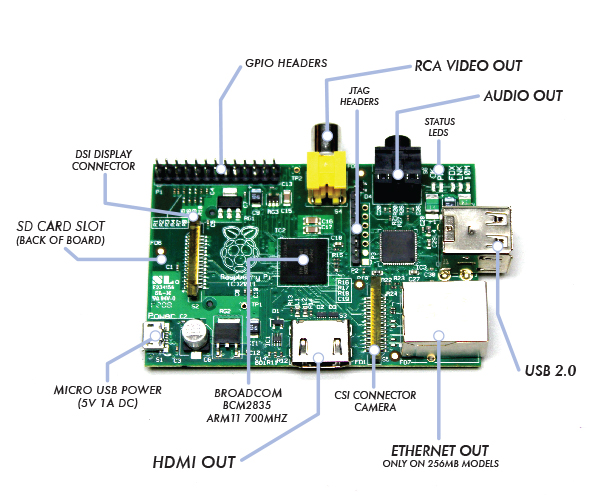The wonderful piece of hardware, Raspberry Pi came to life as little more than a prototype in late 2011, knocking around some trade-fairs. But even at this point, it had been in development for over four years. Its principal motivation was to make computing accessible, with a plan to give the boards to school kids in the hope they’d get enthusiastic about hacking on the devices, just as the Raspberry Pi’s founders had done with their home computers in the 80s. The Raspberry Pi sold half a million units in 6 months, not into the educational market it was designed to revolutionize, but into a wide demographic of hackers, makers and tinkerers.
Features of Raspberry Pi Single Board Computer
Before getting into what the Raspberry Pi can do, we need to examine what you get with it. The system comes in two different flavors: Model A and Model B. The main differences between the two are USB ports (Model A has one, Model B has two), Ethernet (Model A doesn’t have it, model B does), and power usage (in no small part because of that Ethernet jack, Model B uses almost half again as much power as the Model A). But in most other respects, the hardware is the same.

And what hardware it is! The Raspberry Pi is a Broadcom BCM2835 system on a chip (meaning, for these purposes, a bare circuit board), which unites a 700MHz ARM1176JZF-S CPU with a Broadcom VideoCore IV GPU, and 256MB of SDRAM. Those USB 2.0 ports are your only external data connectivity options, although there are two video outputs in the form of composite RCA and HDMI ports, a 3.5mm audio output, and an SD/MMC/SDIO card slot that is the extent of how you can access storage. The Raspberry Pi draws its power from a micro USB adapter, with minimum ratings of 500mA (2.5 watts) for the Model A and 700 mA (3.5 watts) for the Model B—but you’ll need to provide it for yourself, as one does not come with the Raspberry Pi. (Chances are you’ll be able to repurpose the charger for your mobile phone or tablet.) Oh yeah, and did we mention that, measuring about 0.6 by 2.1 by 3.4 inches (HWD), it’s not much bigger than a credit card?
In other words, the Raspberry Pi is as basic as basic can be. And that’s exactly the point. It’s not designed for performance- more on that in a minute—it’s designed as a platform: for education, for expansion, for technological enlightenment. And at that it succeeds. But its bare nature and lack of even rudimentary features—in addition to the lack of an included power cable or even case, there’s no off button; plugging or unplugging the micro USB cable turns it on or off—mean that it isn’t remotely for everyone. But even the adventurous types who are likely its target audience will need to approach it cautiously and be aware of the challenges it presents, particularly at the very start.
 BINARYUPDATES.COM EMBEDDED SYSTEMS TRAINING
BINARYUPDATES.COM EMBEDDED SYSTEMS TRAINING
